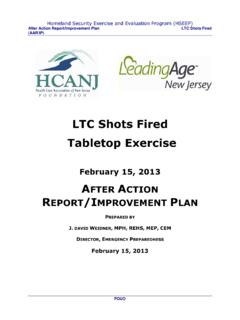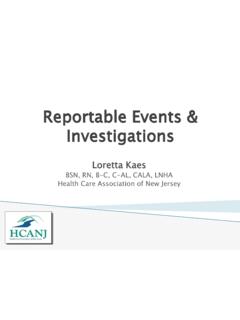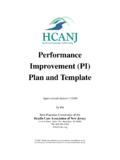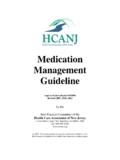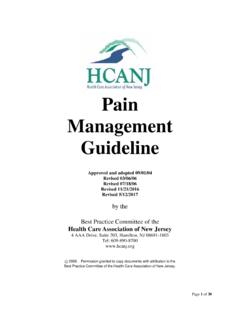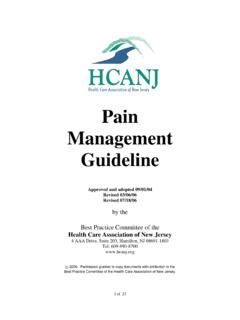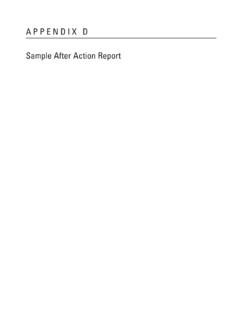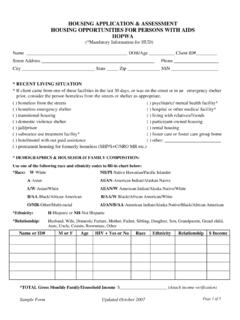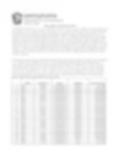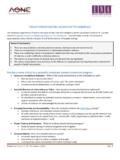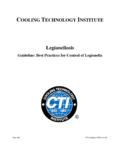Transcription of Rehospitalization - QAPI - Jennifer Gross - HCANJ
1 3/13/201311 Reducing Your RehospitalizationRate the qapi Way Jennifer Gross BSN RN BC RAC CTSenior Healthcare Specialist PointRight Inc. 2 Session Objectives Review why and how Rehospitalization is on the forefront of our industry s consciousness Understand the 5 key elements of Quality Assurance Performance Improvement ( qapi ) in Nursing Homes Understand best practices for achieving compliance with qapi standards Describe three key steps needed to apply qapi elements to your Facility s RehospitalizationReduction Program3/13/201323 The Issue Cost of Rehospitalization is around $17 billion for Medicare recipients Almost 20% of all Medicare hospital stays result in readmission within 30 days of discharge 20 40% of re hospitalizations are avoidable Rehospitalization is a symptom of care fragmentation Current momentum for change.
2 Including legislation is in place4A Little History Lesson on Medicare Payment Advisory Commission (MedPAC) 2005 Study Reported increased Rehospitalization rates for Medicare beneficiaries within 30 days of hospital discharge Identified five conditions for which Rehospitalization is potentially avoidable in nursing homes Congestive Heart Failure Respiratory Infection Urinary Tract Infection Sepsis Electrolyte Imbalance Endorsed addition of quality measures specific to short stay residents including rehospitalization3/13/201335A Little History Care Transitions QIO work on Care Transitions 9th and 10th SOW ACA.
3 Community based Care Transitions Program (Section 3026) Pay For Performance (P4P) Demonstration November 2008 ACA: Value based purchasing (Section 3006) Affordable Care Act implementation in 2010 had further provisions that impact subacute and long term care: Bundled Payments initiative (Section 3023) Medicare Shared Savings Program (Section3022) hospital Readmissions Reduction Program (Section 3025)6 PPACA/ACA 10 Sections (Titles) Quality, Affordable Coverage for All Americans (private health insurance) The Role of Public Programs (Medicaid) Improving the Quality and Efficiency of Health Care (Medicare and quality improvement) Prevention of Chronic Disease and Improving Public Health Health Care Workforce Transparency and Program Integrity (fraud and abuse etc.)
4 Improving Access to Innovative Medical Therapies (biopharmaceutical similars) CLASS Act (disability support) 10/14/2011 removed Revenue Provisions Strengthening Quality, Affordable Health Care for All (amendments to titles I IX)3/13/201347 Title III The quality/efficiency improvements are many, and most are experiments. For example: Penalizing hospitals with high rates of hospital acquired infections and/or preventable readmissions; Moving away from fee for service payments to hospitals and physicians by encouraging formation of "accountable care organizations," "medical homes," and other innovations; Setting up a board to reduce Medicare costs if they grow above a certain level, called the Independent Payment Advisory Board (IPAB); Creating the first ever national quality improvement Hospitalization PatternsJencks et al.
5 N Engl J Med 2009;360:1418-28 New Readmission Reduction Program (HRRP) Penalizes Hospitals with High Readmission Rates High rates of hospital readmissions have gained scrutiny due to cost and quality concerns Nearly 1 in 5 Medicare patients discharged from the hospital is readmitted within 30 days at a cost of over $15 billion every year * Wide variation in readmission rates suggest readmissions can be reduced* MedPAC June 2007 Section 3025 of ACA added section 1886(q) to the Social Security Act establishing the hospital Readmissions Reduction Program, which requires CMS to reduce payments to IPPS hospitals with excess readmissions10 HRRP Penalizes Hospitals with High Readmission Rates The HRRP began October 1, 2012 Payment reduction determined by an adjustment factor based on an assessment of readmissions, with a maximum payment reduction of 1 percent in 2013, 2 percent in 2014, and 3 percent in 2015 and beyond For each hospital .
6 An excess readmissions ratio will be calculated based on measures of readmissions currently used in the hospital inpatient quality report (IQR) programCMS has been calculating (and publishing) hospital readmission rates for hospital quality reporting, HRRP links payments to performance on their measures3/13/2013611 Three Conditions Targeted for FY 2013 and Expanded in FY 2015FY 2013 Acute Myocardial Infarction Heart Failure PneumoniaThese three conditions made up approximately 10% of hospital discharges in 2009FY 2015 Chronic Obstructive Pulmonary Disease Coronary Artery Bypass Graft Percutaneous Transluminal Coronary Angioplasty Other Vascular Conditions12 Three Conditions are All the Rage!
7 Condition at hospital Discharge 30 Day Rehospitalization RateAMI (Heart Attack) Failure (HF) Department of Health and Human Services, Quarter 2, 20123/13/2013713 How the Rates Are Calculated: CMS Uses an Excess Readmissions Ratio The ratio examines the hospital s expected and actual impact on readmissions The performance is measured against an average hospital with similar patients These data are converted into numerator and denominator for the excess readmission ratio.
8 Actual Adjusted ReadmissionsExpected Readmissions With risk adjustment, it is possible for a hospital to have a high observed readmissions rate, but a favorable excess readmissions ratio14 hospital Readmission Reduction Recap Beginning in FY2013, reduced payments to hospitals based upon potentially preventable Medicare readmission Uses National Quality Forum risk adjusted measures: heart failure, acute MI and pneumonia Secretary has the authority to expand the policy to additional conditions hospital Compare publishes Rehospitalization rates Medicare will penalize poorly performing institutions started October 2012 Withhold a percentage of their payments, starting at 1% and rising to 3% within three years as part of the value based purchasing initiative THE SO WHAT ?
9 What will hospitals do to decrease readmissions? Ideally: correctly match the care needs of the patient to the SNF setting? Or simply to those with the lowest Rehospitalization What About Me?True or False: HRRP Impacts Only Acute Care/VA Hospitals?163/13/2013917 Drivers of Rehospitalization Fragmentation of patient information Inappropriate end of life care Medication issues At risk patients not properly identified at discharge Lack of post discharge follow up Lack of disease specific protocols Patient non adherence to the plan of care Patient/family knowledge deficit18 The SNF Challenge.
10 Definition, Volume & Consistency There is NO CMS endorsed SNF rehospitalizationmetric today Most Medicare patients who do not directly return to home are discharged to SNFs Of those, more than 20% return to hospital within 30 days A majority of these rehospitalizations (90%) are unplanned The 30 day Rehospitalization rates vary greatly between SNFs some have rates over 40% and others have rates under 10%.Why is there such a range? Is it all about the quality of care delivered in these nursing homes?3/13/20131019 Analysis: The Relationship of Patient Acuity on Rehospitalization Patient acuity plays a major role in the SNF s ability to prevent Rehospitalization Acuity, diseases and conditions all impact this experience PointRight modeled the 30 day Rehospitalization risk for individual Medicare SNF admissions using MDS data from over 2000 facilities Independent variables were stable indicators present on first MDS assessment Using the model to calculate an expected rate, we computed an adjusted rate.
